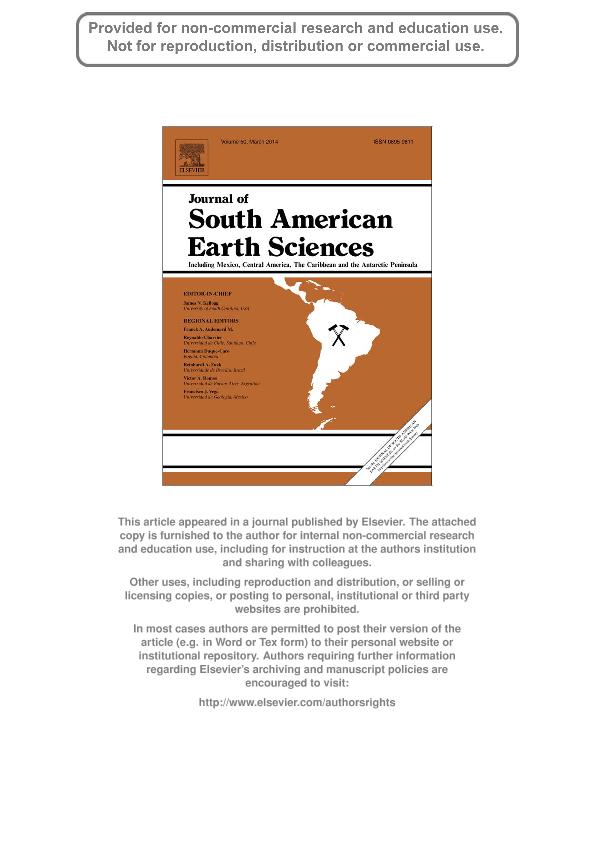Artículo
Emplacement of the La Peña alkaline igneous complex, Mendoza, Argentina (33° S): Implications for the early Miocene tectonic regime in the retroarc of the Andes
Fecha de publicación:
01/2014
Editorial:
Elsevier
Revista:
Journal of South American Earth Sciences
ISSN:
0895-9811
Idioma:
Inglés
Tipo de recurso:
Artículo publicado
Clasificación temática:
Resumen
The La Peña alkaline complex (LPC) of Miocene age (18–19 Ma) lies on the eastern front of the Precordillera (32°41ʹ34ʺS, 68°59ʹ48″W, 1400–2900 m a.s.l.), 30 km northwest of Mendoza city, Argentina. It is a subcircular massif of 19 km2 and 5 km in diameter, intruded in the metasedimentary sequence of the Villavicencio Formation of Silurian-Devonian age. It is the result of integration of multiple pulses derived from one or more deep magma chambers, which form a suite of silicate rocks grouped into: a clinopyroxenite body, a central syenite facies with a large breccia zone at the contact with the clinopyroxenite, bodies of malignite, trachyte and syenite porphyry necks, and a system of radial and annular dikes of different compositions. Its subcircular geometry and dike system distribution are frequent features of intraplate plutons or plutons emplaced in post-orogenic settings. These morphostructural features characterize numerous alkaline complexes worldwide and denote the importance of magmatic pressures that cause doming with radial and annular fracturing, in a brittle country rock. However, in the LPC, the attitude of the internal fabric of plutonic and subvolcanic units and the preferential layout of dikes match the NW–SE extensional fractures widely distributed in the host rock. This feature indicates a strong tectonic control linked to the structure that facilitate space for emplacement, corresponding to the brittle shear zone parallel to the N–S stratigraphy of the country rock. Shearing produced a system of discontinuities, with a K fractal fracture pattern, given by the combination of Riedel (R), anti-Riedel (R′), (P) and extensional (T) fracture systems, responsible for the control of melt migration by the opening of various fracture branches, but particularly through the NW–SE (T) fractures. Five different pulses would have ascent, (1) an initial one from which cumulate clinopyroxenite was formed, (2) a phase of mafic composition represented by dikes cross-cutting the clinopyroxenite, (3) a malignite facies that causes a small breccia in the clinopyroxenite, (4) a central syenite facies that develops breccias at the contact with the clinopyroxenite and, finally, (5) porphyry necks and a system of radial dikes intruding all units. At the moment of the emplacement different mechanisms would have acted, they summarized in: 1) opening of discontinuities synchronous to the magma circulation as the principal mechanism for formation of dikes and conduits; 2) stoping processes, that play an important role in the development of the breccia zone and enabling an efficient transference of material during the emplacement of the syenitic magma and 3) shear-related deformation (regional stress), affected the internal fabric of the facies, causing intracrystalline deformation and submagmatic flow, which is very evident in the central syenite intrusive. The kinematic analysis of shear planes allows proposing that emplacement of the LPC took place in a transtensive regime, which would have occurred in the back-arc of the Andes orogen, during a long period spanning from Miocene to the present, of the compressive deformation responsible, westward and at the same latitude, for the development of the Aconcagua fold and thrust belt.
Palabras clave:
Alkaline Complex
,
Miocene
,
Shear Zone
,
Transtensive Regime
,
Precordillera
,
Mendoza
Archivos asociados
Licencia
Identificadores
Colecciones
Articulos(IANIGLA)
Articulos de INST. ARG. DE NIVOLOGIA, GLACIOLOGIA Y CS. AMBIENT
Articulos de INST. ARG. DE NIVOLOGIA, GLACIOLOGIA Y CS. AMBIENT
Citación
Marquez Zavalia, Maria Florencia; Galliski, Miguel Angel; Pagano Género, Diego Sebastián; Emplacement of the La Peña alkaline igneous complex, Mendoza, Argentina (33° S): Implications for the early Miocene tectonic regime in the retroarc of the Andes; Elsevier; Journal of South American Earth Sciences; 50; 1-2014; 48-66
Compartir
Altmétricas




